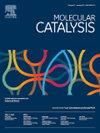The active site of Mδ+ tailed by B (or N)-doped graphyne for nitrogen reduction reaction through DFT study
IF 3.9
2区 化学
Q2 CHEMISTRY, PHYSICAL
引用次数: 0
Abstract
N![]() N bond activation is one of the technical problems in the conversion of N2-to-NH3. In this work, we researched Cr, Mn, Co, Ni, Cu and Pt metal single atoms anchored on B/N-doped graphyne (M/X-GY) catalysts systematically by means of DFT. The results of Bader charge and charge density verified the charge transfers between single metal and the doped graphyne in M/X-GY catalysts. Cr (+1.001 e) and Mn (+0.800 e) exhibit higher positive valence, which is favorable for N2 adsorption. Based on the "donation and back-donation" mechanism, the energies gaps of 5σ-N2 and d-M for M=Cr, Mn and Co have the lower values of 3.01, 3.18, 3.18 eV, respectively, and the N2 adsorption energies on Cr/GY (−2.046 eV) and Mn/GY (−1.622 eV) have the more negative values. As a result, the catalyst of Cr metal atom anchored on GY is promising candidate. The substitution of B can effectively promote the activation of N2 and suppress the hydrogen evolution, while the substitution of N has the minimum ΔG*N-NH of 0.26 eV and ΔGNH3 of 0.08 eV. Compared with two different NRR pathways, the distal mechanism process is more preferential than the alternating pathway. The catalyst of Cr/N-GY has higher stability and can effectively activate N2 to generate *N2H, which can serves as promising catalysts throughout the NRR process.
N bond activation is one of the technical problems in the conversion of N2-to-NH3. In this work, we researched Cr, Mn, Co, Ni, Cu and Pt metal single atoms anchored on B/N-doped graphyne (M/X-GY) catalysts systematically by means of DFT. The results of Bader charge and charge density verified the charge transfers between single metal and the doped graphyne in M/X-GY catalysts. Cr (+1.001 e) and Mn (+0.800 e) exhibit higher positive valence, which is favorable for N2 adsorption. Based on the "donation and back-donation" mechanism, the energies gaps of 5σ-N2 and d-M for M=Cr, Mn and Co have the lower values of 3.01, 3.18, 3.18 eV, respectively, and the N2 adsorption energies on Cr/GY (−2.046 eV) and Mn/GY (−1.622 eV) have the more negative values. As a result, the catalyst of Cr metal atom anchored on GY is promising candidate. The substitution of B can effectively promote the activation of N2 and suppress the hydrogen evolution, while the substitution of N has the minimum ΔG*N-NH of 0.26 eV and ΔGNH3 of 0.08 eV. Compared with two different NRR pathways, the distal mechanism process is more preferential than the alternating pathway. The catalyst of Cr/N-GY has higher stability and can effectively activate N2 to generate *N2H, which can serves as promising catalysts throughout the NRR process.
通过 DFT 研究 B(或 N)掺杂石墨烯尾 Mδ+ 的活性位点用于氮还原反应
NN 键活化是 N2 转化为 NH3 的技术难题之一。在这项工作中,我们通过 DFT 系统地研究了锚定在掺杂 B/N 的石墨烯(M/X-GY)上的 Cr、Mn、Co、Ni、Cu 和 Pt 金属单原子。巴德电荷和电荷密度的结果验证了 M/X-GY 催化剂中单个金属和掺杂石墨之间的电荷转移。铬(+1.001 e)和锰(+0.800 e)表现出较高的正价,有利于 N2 的吸附。基于 "捐献和反捐献 "机理,M=Cr、Mn 和 Co 的 5σ-N2 和 d-M 的能隙分别为 3.01、3.18 和 3.18 eV,且 Cr/GY (-2.046 eV)和 Mn/GY (-1.622 eV)上的 N2 吸附能为负值。因此,Cr 金属原子锚定在 GY 上的催化剂是很有前景的候选催化剂。B 的取代能有效促进 N2 的活化并抑制氢的进化,而 N 的取代具有最小的 ΔG*N-NH 0.26 eV 和 ΔGNH3 0.08 eV。与两种不同的 NRR 途径相比,远端机制过程比交替途径更优。Cr/N-GY催化剂具有更高的稳定性,并能有效活化N2生成*N2H,可在整个NRR过程中发挥催化剂的作用。
本文章由计算机程序翻译,如有差异,请以英文原文为准。
求助全文
约1分钟内获得全文
求助全文
来源期刊

Molecular Catalysis
Chemical Engineering-Process Chemistry and Technology
CiteScore
6.90
自引率
10.90%
发文量
700
审稿时长
40 days
期刊介绍:
Molecular Catalysis publishes full papers that are original, rigorous, and scholarly contributions examining the molecular and atomic aspects of catalytic activation and reaction mechanisms. The fields covered are:
Heterogeneous catalysis including immobilized molecular catalysts
Homogeneous catalysis including organocatalysis, organometallic catalysis and biocatalysis
Photo- and electrochemistry
Theoretical aspects of catalysis analyzed by computational methods
 求助内容:
求助内容: 应助结果提醒方式:
应助结果提醒方式:


